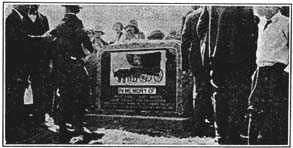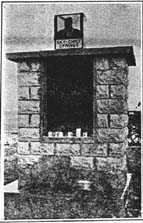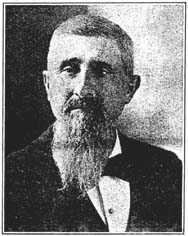
ERECT MONUMENT TO PIONEERS
Resource
Center
On-Line Library
Journals
NE History & Record of Pioneer Days
Vol VII, no 2 (part 2)
| 46 |
|

ERECT MONUMENT TO PIONEERS
On May 26, 1885, four families of Bohemian
emigrants traveling in three covered wagons drawn by ox teams,
camped in Richmond canyon about midway between Bartley and
Cambridge at point where the D. L. D. highway now crosses. About 9
o'clock a wall of water came down the canyon and swept the entire
camp away. Of the seventeen members of the party, men, women and
children, three women and six children were drowned. To
commemorate this incident in the early history of Red Willow
county, a monument has been erected close to the place where these
emigrants camped for the night and exercises were held there
yesterday, participated in by fully twnty-five (sic) hundred
persons, who gathered from all parts of southwestern Nebraska. The
exercises consisted of music by the Cambridge band and addresses
by Honorable C. E. Eldred, of McCook, Honorable B. F. Butler of Ca
bridge, Honorable A. M. Keyes, of Holbrook and others.
The ceremony was especially solemn and
impressive because of the presence of two of the three living
survivors John Osmera and Mary Osmera, his sister, of Brainard,
Nebr. The only remaining living survivor of the disaster is Mary
Vlostin of St. Paul, Nebr. The gathering included a large number
of persons who were residents of the county thirty-nine years ago,
when the water overwhelmed the campers and several were present
who had searched for and found the bodies of the dead.
Mr. Osmera's account of the disaster, which he
could not give publicly, but which he told individual inquirers,
was that he and his sister who had survived, were sleeping in one
of the wagons. About that evening the water from a cloud burst
somewhere north came down the canyon. His father was aroused and
rescued himself and his sister, then went to the assistance of his
mother and another brother and sister, who were in another wagon,
but it was too late. They had been swept away. The party was on
its way to homestead lands in Hayes county.
The monument is a granite slab bearing the names of the
women who were drowned, the date of the occurence (sic) and a brief statement
the destination of the party. The project of placing the monument at the spot
originated with D. F. Neiswanger of Cambridge. The expenses amounting to about
$300.00 are to be paid by popular subscription. It is desired, if possible
to limit these subscriptions to $1.00 each.
| |
47 |
John F. Cordeal, of this place has consented to accept subscriptions from those in this vicinity who desire to contribute to the fund.
After the dedication of the monument in
Richmond canyon, a spring about two and a half miles east of
Cambridge, which has been given the name of Sky Chief, the last
chief of the Pawnees, was dedicated. The water has been piped from
the side of the hill to the side of the road and a shelter
erected. This will prove a source of comfort and convenience to
travelers along the D. L. D. highway.
The day was perfect for a celebration of the
character of this and the crowd that gathered was in a reverential
mood. -- Beaver City Tribune.
_____
NOTE: See Czech's
in Nebraska for article on this incident.

Editor of the Trenton Leader made a journey across the state from Trenton to Pineridge reservation in South Dakota in June for the purpose of securing a number of Indians to take part in the Massacre Cent Year celebration held at Trenton August 4, 5 and 6. He was successful in securing a number of Sioux who were engaged in the battle with the Pawnees at that time.
Hugh McFadden, 84, died at Roseburg, Oregon, June 16, 1924, from an automobile accident. He was a soldier in company C of the 5th Cavalry, served for five years on the Nebraska frontier, part of the time at old Fort Sidney. After discharge from the army he married and conducted a hotel at Sidney for many years. He was a well known character, highly esteemed, who gave of his counsel and courage in both civil and military life toward the settlement and development of Nebraska and western frontier.

ELIJAH FILLEY, LEADER IN IMPROVED FARMING
(By H. Clyde Filley.)
A Paper Read Before the
Nebraska Hall of Agricultural Achievement,
at Lincoln, Nebraska, January, 1924
Elijah Filley was born in a log cabin in
Jackson County, Michigan, November 28, 1839. He died at Beatrice,
Nebraska, March 31, 1920.
Eighty years is a long span of life, but length
in years is not a true measure of either life or its living. What
has a man seen? What has he learned? What has he accomplished?
What have been his joys and his sorrows? What has he done for
himself and for others? How much has a man appreciated the
opportunity of living, of taking part in the movement of events,
and how much better is the world because he lived? What was his
contribution to the sum total of human happiness? These are the
things that count rather than mere length of years.
Certain it is that the octogenarians of no other
country or period ever had the opportunity to witness such a
development of natural resources, and such an advance in science
and invention as those who lived in the United States from about
1840 to about 1920. In few places were the changes greater than in
the great Middle West.
In 1840 there were less than 3000 miles of
railway in the United States and no road had as yet crossed the
Mississippi. Morse did not build his first telegraph line until
1844, and Bell did not construct his first crude telephone until
1876.
Science and invention have wrought a marvelous
change in agriculture since 1840. When hardly more than a boy
Elijah Filley cut grain with a cradle; as a young man he bound
grain, following a Mc-
| |
49 |
Cormick reaper and assisted in operating a Marsh harvester. He
was one of the many farmers to rejoice over the invention of the
Applebee binder and the many additions and improvements that have
been made in harvesting machinery within the last half century.
During his lifetime the threshing machine replaced the flail; the
corn planted with check row attachment ended the planting of field
corn with a hoe; the corn cultivator, the milking machine, the
gasoline engine, the automobile and other inventions came to the
aid of the farmer increasing his efficiency and lightening his
labor.
In 1840 Michigan was a pioneer state, Chicago
was little more than a village, and the frontier had hardly
crossed the Mississippi into Iowa. Nebraska was not even organized
as a territory until 1854 and did not develop rapidly until after
the close of the Civil War. We know the Nebraska of today, -- its
cities, its schools and its agriculture. What part in all this
development was taken by Elijah Filley?
The boyhood of Elijah Filley was very similar to
the boyhood of many other sons of pioneers in a timbered country.
He attended school in winter and worked on the farm in summer. The
cleared acreage gradually increased and the number of stumps and
stones in the fields decreased, due in part to his efforts.
In the spring of 1858 when he was eighteen years
of age, he went to Joliet, Illinois. He worked on a farm that
summer and helped saw wood with a horse power saw for the Rock
Island Railroad the following winter.
In 1859 he went to Livingston County, Illinois,
where he worked on a farm for about a year. He was then hired by
William Straun, who was one of the largest cattle feeders in
Illinois. This employment was particularly fortunate because he
not only earned wages, but had the opportunity of learning the
cattle business. Mr. Straun needed a helper who could do more than
carry out his daily routine and wish for quitting time. He was
buying cattle over a wide area in a region where there were no
railroads. These cattle must be driven to his feed yards, fattened
and sold. He soon came to appreciate the initiative of the young
man from Michigan, taught him as much about judging, buying, and
feeding cattle as he could, and gradually increased his
responsibilities. During a part of his term of employment with
William Straun, Elijah Filley bought cattle of farmers, collected
them into droves, and drove them to the feed yards, letting them
graze along the route by day, and placing them in some farmer's
corral by night. It was experience which fitted him well for his
work in later years.
On November 4, 1863, he was married to Emily J.
Burd of Pleasant Ridge, Illinois. She proved a true helpmate,
being not only a good home maker and mother, but taking an
interest in livestock and other things in which her husband was so
greatly interestel (sic).
In 1867 Mr. Filley moved to Nebraska. He was
accompanied not only by his wife and two small sons but also by
his father, Ammi Filley. They traveled overland in covered wagons
and reached their destination, which was later to be known as
Cottage Hill Farm, on the 17th day of August. Theirs were the
first two upland homesteads to be taken in Gage County. The few
other early homesteaders had settled in the Blue River Valley and
on the bottom land along the creeks.
That was the day of the dug out, the sod house
and the shanty. Few men were certain that it would be possible to
live that far away from the Missouri River. They wanted to try out
the country for a few years before building any permanent
improvements.
Mr. Filley was less interested in going "back
east" than he was in having eastern comforts in Nebraska. He put
up a tent and started to
© 2001, 2004 for NEGenWeb Project by Ted & Carole Miller